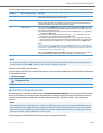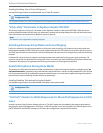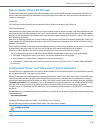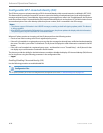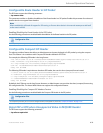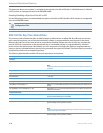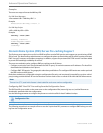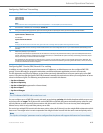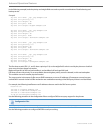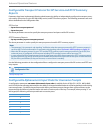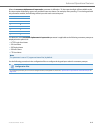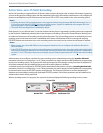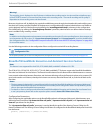
Advanced Operational Features
41-001343-02 REV04 – 05.2014 6-37
Configuring “DNS Host” Pre-caching
Configuring DNS “Service (SRV) Records” Pre-caching
In addition to using a host file to resolve host names to IP addresses, an Administrator can also configure DNS “SRV
records” (Service Records) for geographic redundancy and failover between application servers in the network.
The SIP registration and SIP proxy features on the phones previously allowed the use of server queries only to live DNS
servers. Using the host file and specific DNS SVR parameters extends this mechanism to allow pre-configuration of server
values in the aastra.cfg file. The following new parameters are used for this feature:
• sip dns srvX name
• sip dns srvX priority
• sip dns srvX weight (supported in a future release)
• sip dns srvX port
• sip dns srvX target
You can configure up to 4 DNS SRV records, with each server having a priority which tells the phone which server to use,
and a host name or target. The IP phone will use the DNS SRV record with the lowest-numbered priority value first, and
will only failover to other records if the connection with this record's host fails. Thus a service may have a designated
failover server, which is only used if the primary server fails.
If a service has multiple SRV records with the same priority value, the IP phone(s) use the weight field to determine which
host to use. The weight value is a ratio compared to the weight of other records with the same name and priority value.
1. Using a text-based editing application, create a blank text file
2. Enter the IP addresses of the DNS servers in your local network. For example:
1.2.3.4 server1
5.6.7.8 server2
9.0.1.2 server3
Note:
Ensure each line uses a Carriage Return (CR) or Carriage Return + Line Feed (CRLF) to terminate the line.
3. Save the file as “<filename>.txt”. For ex amp le, “hostfile.txt”.
4. Using a text-based editing application, open the aastra.cfg file for the phone(s) for which you want to apply the DNS hostfile.
5. Enter the following parameter in the aastra.cfg file followed by the host file name as the value:
sip dns host file: <filename>.txt
For example:
sip dns host file: hostfile.txt
Note:
If using a text file on a PC to enter this value, you must enter a carriage return (CR) after entering the host file name.
6. Save the file. Make sure the aastra.cfg and the hostfile.txt files are on the configuration server in your network before downloading to the
phone(s).
7. Restart the phone(s) in your network.
The phone(s) downloads the specified host text file and stores it locally on the phone’s flash memory. Upon each subsequent boot of the
phones, if the host text file is available on the configuration server, it is downloaded to replace the locally cached copy; otherwise, the pre-
viously cached copy is retained and used unchanged.
The configuration of the phone(s) can now use server1, server2, or server3 for SIP or other services instead of using the IP addresses. The
phones will continue resolving the host names even if DNS on the network has conflicting or missing entries for server1, server2, or server3,
or if the local LAN DNS server fails to respond.
Note:
The “X” indicates a DNS SRV with a value from 1 to 4.
Note:
The “sip dns srvX weight” parameter must be configured but the phones will support this feature in a future release.



